跨文化交际翻译练习
- 格式:doc
- 大小:23.00 KB
- 文档页数:1
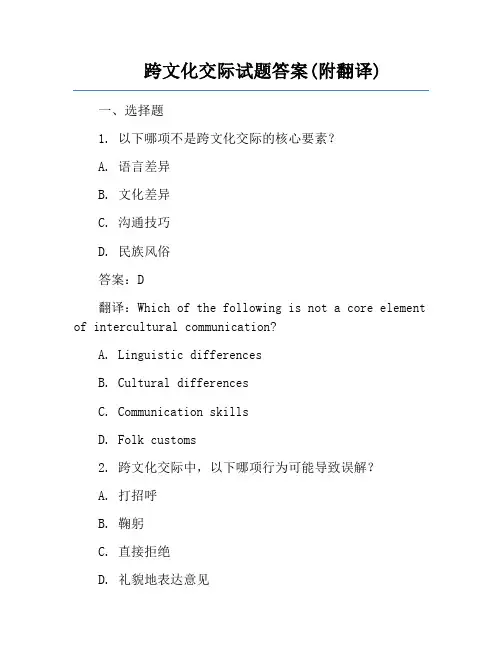
跨文化交际试题答案(附翻译)一、选择题1. 以下哪项不是跨文化交际的核心要素?A. 语言差异B. 文化差异C. 沟通技巧D. 民族风俗答案:D翻译:Which of the following is not a core element of intercultural communication?A. Linguistic differencesB. Cultural differencesC. Communication skillsD. Folk customs2. 跨文化交际中,以下哪项行为可能导致误解?A. 打招呼B. 鞠躬C. 直接拒绝D. 礼貌地表达意见翻译:In intercultural communication, which behavior may lead to misunderstandings?A. GreetingB. BowingC. Direct refusalD. Politely expressing opinions二、填空题1. 跨文化交际中的文化差异主要体现在____、____、____等方面。
答案:价值观、行为规范、语言使用翻译:The cultural differences in intercultural communication are mainly reflected in values, behavioral norms, and language use.2. 跨文化交际能力包括____、____、____等方面。
答案:知识、技能、态度翻译:Intercultural communication competence includes knowledge, skills, and attitudes.三、简答题1. 简述跨文化交际的重要性。
跨文化交际在全球化背景下具有重要意义。
以下是跨文化交际的重要性:(1)促进国际交流与合作:跨文化交际有助于不同国家和地区的人们相互了解,增进友谊,促进国际合作。

1. He’s just a green recruit fresh from college.缺乏经验的;不成熟的;幼稚的
翻译:他是个刚从大学毕业征召入伍的新兵。
2.I tried to call her many times but she was in a brown study and didn’t hear me.
深思,出神a state of deep absorption or thoughtfulness
翻译:我叫了她好几声,但她一直在沉思当中,并没有听见我的声音。
3. One day, out of the blue, a girl rang up and said she was my sister. 忧郁;沮丧;悲伤翻译:某天,出乎意料地,一个女孩给我打电话说她是我妹妹。
4. The new office block has unfortunately become an expensive white elephant.
累赘物,摆设物
翻译:这座新的办公楼步行地成了昂贵的摆设。
5.Mary was always regarded as t he black sheep of the family.
害群之马,败类,败家子
翻译:Mary总是被认为是败家子。
6. You’d better do something to prove you’re not yellow. 胆怯的
翻译:你最好做出点什么来证明你不是胆小鬼。
7.Can you see the green in her eyes? Green: adj. 由强烈感情影响的;嫉妒的。
翻译:你能看出她眼中的嫉妒之情吗?。
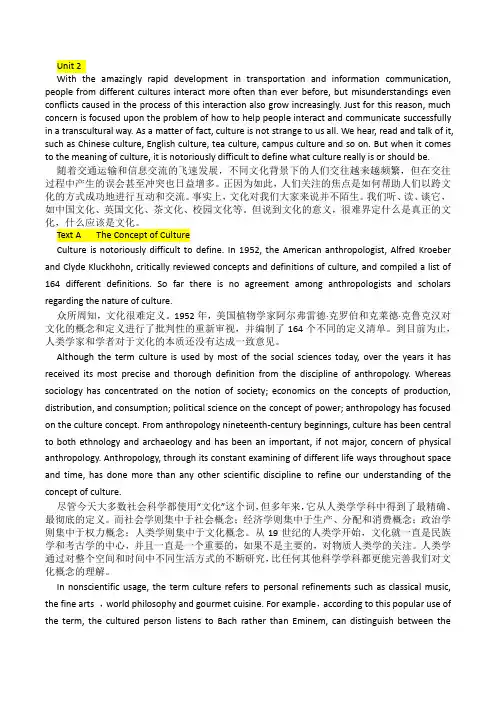
Unit 2With the amazingly rapid development in transportation and information communication, people from different cultures interact more often than ever before, but misunderstandings even conflicts caused in the process of this interaction also grow increasingly. Just for this reason, much concern is focused upon the problem of how to help people interact and communicate successfully in a transcultural way. As a matter of fact, culture is not strange to us all. We hear, read and talk of it, such as Chinese culture, English culture, tea culture, campus culture and so on. But when it comes to the meaning of culture, it is notoriously difficult to define what culture really is or should be.随着交通运输和信息交流的飞速发展,不同文化背景下的人们交往越来越频繁,但在交往过程中产生的误会甚至冲突也日益增多。
正因为如此,人们关注的焦点是如何帮助人们以跨文化的方式成功地进行互动和交流。
事实上,文化对我们大家来说并不陌生。
我们听、读、谈它,如中国文化、英国文化、茶文化、校园文化等。

1、【communication across cultures】Chapter One Conceptual Foundation【跨文化沟通】第一章概念的基础Why study intercultural communication?为什么学习跨文化交际?There is a folk tale that comes to us from the foothills of the Himalayas. A man was trying to explain to a blind friend what colors are. He began with the color White.有一个民间的故事,来自于喜马拉雅山的山麓。
一名男子试图解释一个盲人朋友的颜色是什么。
他开始与雪白的颜色。
“Well,”he said, “it is like snow on the hills.”“嗯,”他说,“这就像雪在山上。
”“Oh,”the blind man said, “then it must be a wet and dampish sort of color, isn’t it? ”“No, no,”the man said, “it is also the same color as cotton or wool. ”“Oh yes, I understand. It must be fluffy color. ”“No, it is also like paper.”“哦,”盲人说,“那一定是湿,微湿的颜色,不是吗?”“不,不,”那人说,“这也是相同的颜色,棉或羊毛。
”“哦,是的,我明白了。
一定是毛茸茸的颜色。
”“不,它也像纸。
”“Then it must be a crackling or fragile color,”said the blind man. “No, not at all. It is also like china.”“那一定是脆皮或脆弱的颜色,”瞎子说。
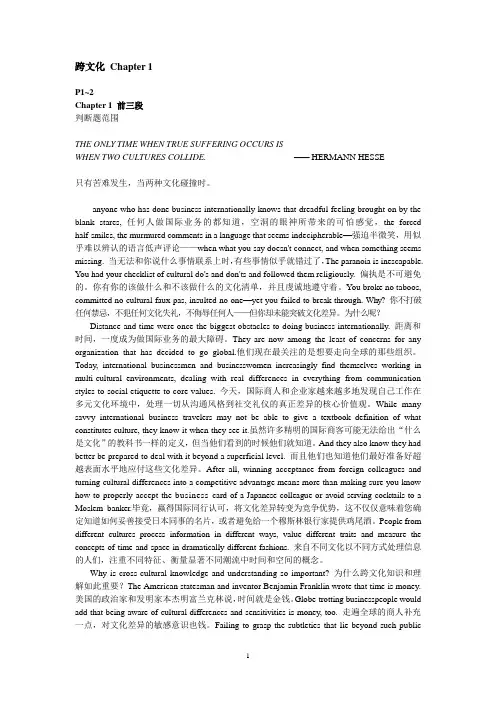
跨文化Chapter 1P1~2Chapter 1 前三段判断题范围THE ONLY TIME WHEN TRUE SUFFERING OCCURS ISWHEN TWO CULTURES COLLIDE. —— HERMANN HESSE只有苦难发生,当两种文化碰撞时。
anyone who has done business internationally knows that dreadful feeling brought on by the blank stares,任何人做国际业务的都知道,空洞的眼神所带来的可怕感觉,the forced half-smiles, the murmured comments in a language that seems indecipherable—强迫半微笑,用似乎难以辨认的语言低声评论——when what you say doesn't connect, and when something seems missing.当无法和你说什么事情联系上时,有些事情似乎就错过了,The paranoia is inescapable. You had your checklist of cultural do's and don'ts and followed them religiously.偏执是不可避免的。
你有你的该做什么和不该做什么的文化清单,并且虔诚地遵守着。
You broke no taboos, committed no cultural faux pas, insulted no one—yet you failed to break through. Why?你不打破任何禁忌,不犯任何文化失礼,不侮辱任何人——但你却未能突破文化差异。
为什么呢?Distance and time were once the biggest obstacles to doing business internationally.距离和时间,一度成为做国际业务的最大障碍。
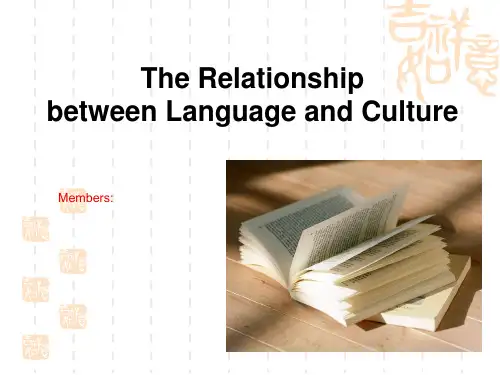
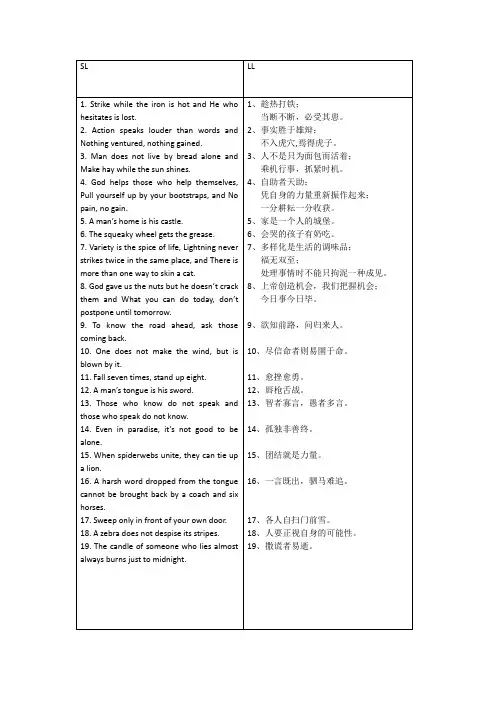
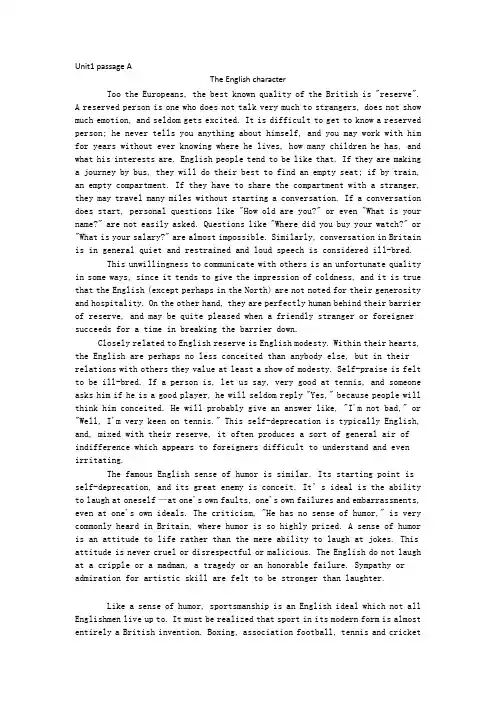
Unit1 passage AThe English characterToo the Europeans, the best known quality of the British is "reserve".A reserved person is one who does not talk very much to strangers, does not show much emotion, and seldom gets excited. It is difficult to get to know a reserved person; he never tells you anything about himself, and you may work with him for years without ever knowing where he lives, how many children he has, and what his interests are. English people tend to be like that. If they are making a journey by bus, they will do their best to find an empty seat; if by train, an empty compartment. If they have to share the compartment with a stranger, they may travel many miles without starting a conversation. If a conversation does start, personal questions like "How old are you?" or even "What is your name?" are not easily asked. Questions like "Where did you buy your watch?" or "What is your salary?" are almost impossible. Similarly, conversation in Britain is in general quiet and restrained and loud speech is considered ill-bred.This unwillingness to communicate with others is an unfortunate quality in some ways, since it tends to give the impression of coldness, and it is true that the English (except perhaps in the North) are not noted for their generosity and hospitality. On the other hand, they are perfectly human behind their barrier of reserve, and may be quite pleased when a friendly stranger or foreigner succeeds for a time in breaking the barrier down.Closely related to English reserve is English modesty. Within their hearts, the English are perhaps no less conceited than anybody else, but in their relations with others they value at least a show of modesty. Self-praise is felt to be ill-bred. If a person is, let us say, very good at tennis, and someone asks him if he is a good player, he will seldom reply "Yes," because people will think him conceited. He will probably give an answer like, "I'm not bad," or "Well, I'm very keen on tennis." This self-deprecation is typically English, and, mixed with their reserve, it often produces a sort of general air of indifference which appears to foreigners difficult to understand and even irritating.The famous English sense of humor is similar. Its starting point is self-deprecation, and its great enemy is conceit. It’s ideal is the ability to laugh at oneself —at one's own faults, one's own failures and embarrassments, even at one's own ideals. The criticism, "He has no sense of humor," is very commonly heard in Britain, where humor is so highly prized. A sense of humor is an attitude to life rather than the mere ability to laugh at jokes. This attitude is never cruel or disrespectful or malicious. The English do not laugh at a cripple or a madman, a tragedy or an honorable failure. Sympathy or admiration for artistic skill are felt to be stronger than laughter.Like a sense of humor, sportsmanship is an English ideal which not all Englishmen live up to. It must be realized that sport in its modern form is almost entirely a British invention. Boxing, association football, tennis and cricketwere all first organized and given rules in Britain. Rules are the essence of sport, and sportsmanship is the ability to practise a sport in obedience to its rules, while also showing generosity to one's opponent and good temper in defeat. Moreover, sportsmanship as an ideal is applied to life in general. One of the most elementary rules of life is "never hit a man when he's down"─in other words, never take advantage of another person's misfortune. English school-boys often show this sense of sportsmanship to a surprisingly high degree in their relations with each other.译文:对于其他欧洲人来说,英国人最著名的特点是“谨慎”。
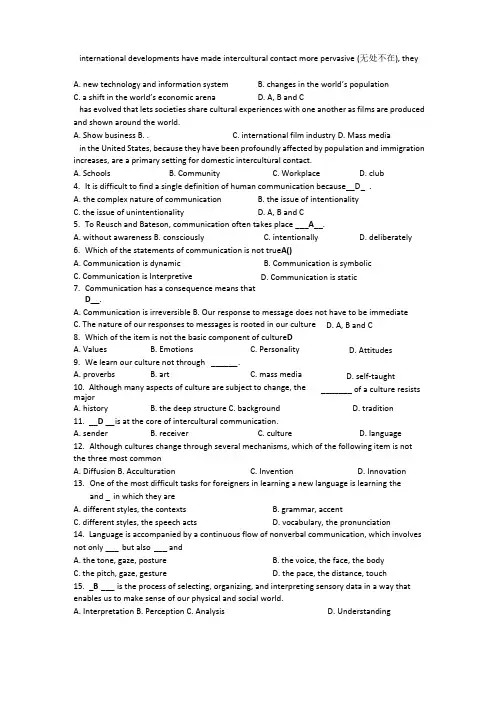
international developments have made intercultural contact more pervasive (无处不在), theyA. new technology and information systemB. changes in the world’s populationC. a shift in the world’s economic arenaD. A, B and Chas evolved that lets societies share cultural experiences with one another as films are produced and shown around the world.A. Show businessB. .C. international film industryD. Mass mediain the United States, because they have been profoundly affected by population and immigration increases, are a primary setting for domestic intercultural contact.A. SchoolsB. CommunityC. WorkplaceD. club4. It is difficult to find a single definition of human communication because__D _ .A. the complex nature of communicationB. the issue of intentionalityC. the issue of unintentionalityD. A, B and C5. To Reusch and Bateson, communication often takes place ___A__.A. without awarenessB. consciouslyC. intentionallyD. deliberately6. Which of the statements of communication is not true A()A. Communication is dynamicB. Communication is symbolicC. Communication is Interpretive 7. Communication has a consequence means thatD__.A. Communication is irreversibleB. Our response to message does not have to be immediateC. The nature of our responses to messages is rooted in our culture 8. Which of the item is not the basic component of culture DA. ValuesB. EmotionsC. Personality 9. We learn our culture not through ______ .A. proverbsB. artC. mass media 10. Although many aspects of culture are subject to change, the majorA. historyB. the deep structureC. backgroundD. tradition11. __D __ i s at the core of intercultural communication.A. senderB. receiverC. cultureD. language12. Although cultures change through several mechanisms, which of the following item is not the three most commonA. DiffusionB. AcculturationC. Invention 13. One of the most difficult tasks for foreigners in learning a new language is learning the and _ in which they areA. different styles, the contextsB. grammar, accentC. different styles, the speech actsD. vocabulary, the pronunciation14. Language is accompanied by a continuous flow of nonverbal communication, which involves not only ___ but also ___ andA. the tone, gaze, postureB. the voice, the face, the bodyC. the pitch, gaze, gestureD. the pace, the distance, touch15. _B ___ is the process of selecting, organizing, and interpreting sensory data in a way that enables us to make sense of our physical and social world.A. InterpretationB. PerceptionC. AnalysisD. Understanding D. Communication is staticD. A, B and CD. AttitudesD. self-taught_______ of a culture resists D. Innovation16.The maps are usually drawn by putting one’s country in the center. This illustrates ___C___.A. MisinterpretationB. Racial biasC. EthnocentrismD. Stereotype17.Many stereotypes are provided by the __D ____ .A. School educationB. TextbookC. HistoryD. Mass media18.Cultural breakdowns, setbacks or conflicts result from misinterpretations, ethnocentrism, and stereotype as a result of B___.A. MisperceptionB. Racial biasC. MisunderstandingD. False impression19.___C__ are defined as “an enduring set of beliefs that serve to guide or direct our behavior”.A. LawsB. PerceptionsC. ValuesD. World views20.Which of the statements about cultural values is not true CA.Cultural values, as is the case with cultural beliefs, guide both perception and communication.B.Cultural values have nothing to do with individual values.C.Cultural values are prescriptive.D.Cultural values, once formed, are enduring and relatively stable.21.Which of the countries doesn’t belong to individualistic culture D()A. ItalyB. New ZealandC. FranceD. Greece22.In a high power distance culture, the superior tends to BA. treat employees respectfullyB. display his authorityC. interact with workers more oftenD. do important work23.Which of the statements about low uncertainty avoidance is not trueA. Divers population.B. Frequent innovations.C. Generally older countries with a long history.D. Citizens are proud of nation.24.Which of the following countries or region of no feminine traits DA. NorwayB. FinlandC. DenmarkD. Austrianguage ____ culturalA. ExpressesB. EmbodiesC. InfluencesD. Symbolizes26.It is a universal truth that language is ___ b y culture and in turn it ______ c ulture. BA. influenced, reflectsB. displayed, influencesC. determined, reflectsD. shaped, influencesnguage is the _____ representation of a people, and it comprises their historical and cultural backgrounds as well as their approach to life and their ways of living andA. PrescriptiveB. AbstractC. SubstantialD. Symbolic28.Which of the contextual cues do not matter in a high-context culture AA.The type of relationship that exists between the speaker and the listener.B.The coded, explicit message.C.Age relative to the speaker and the listener.D.Where is the communication taking place29.The low-context culture doesn’t have which of theA.Tends to develop transitory personal relationship.B.Tends to use "logic" to present ideas.C.Tends to give simple, ambiguous, non-contexting messages.D.Values individualism.30.The following advantages of high-context culturedon’t include A. it saves us making many trivial decisions;B.it allows for great flexibility, adaptability and originality;C.roles tend to be clear;D.group projects and team efforts tend to be practicable and effective.31.People from cultures that prefer “high involvement” styles tend to__A _____ .A.expect to be interruptede polite listening soundC.give plenty of positive and respectful responses to their conversation partnersD.speak one at a time32.People from “high considerateness” cultures are often thought to be _ B___.A. loudB. passiveC. chattyD. pushy33.One way to determine whether a culture favors a direct or indirect style in communication isA .A. How they say, “No.”B. How they invite people.C. How they teach people.D. How they accept people.34.In 2010, the Easter is on ___A ____ .A. 4th, April , April C. 2nd, April D. 6th, April35.Which of the communication style can’t be characterized as high consideratenessAA. ChineseB. JapaneseC. Mainstream AmericanD. RussianDefine the following concept. (4 points for each of the 5 items)(1)Culture (2) Acculturation (3) Stereotype (4) Value (5) Uncertainty avoidance(6) Communication (7) Innovation (8) Perception (9) Ethnocentrism(10) Intercultural communication (11) Power distance (12) high-context True or false.(1)( F ) Cultural generalizations must be viewed not as approximations ( 接近)0£ reality, but as absolute representations.(2)(T ) Domestic contacts are increasing because new immigrants and co-cultures are growing in numbers.(3)( F ) Our response to message has to be immediate.(4)( T ) It is always possible to share our feelings and experiences by means of direct mind-to-mind contact.(5)( T ) Culture is a problem of nurture instead of nature, that is one’s cultural patterns are acquired through learning or interacting, or they are determined by the environment within which we live.(6)( F ) Misinterpretations do result every time members from two cultures communicate.(7)( F ) Ethnocentrism is usually learned at the conscious level.(8)( F) Low uncertainty avoidance cultures tend to have a less efficient infrastructure than high uncertainty avoidance cultures.(9)( T ) China, Korea, Japan, Latin America, and to a certain extent, France, are considered to be high-context cultures.(10)( T ) In the mainstream American culture, the ideal form of communication includes being direct rather than indirect.(11)( T)Communication is an activity that affects people and other people.(12)(T )New technology, and growth in the world’s populationhave contributed to increased international contacts.(13)(F ) All cultures use symbols, but they rarely assign their own meanings to them.(14)( T ) Communication can be retrieved.(15)( ) Patterns of culture are inherent with individual, that is, they are genetically passed down from previous generations.(16)( ) Perceptions for the same object, behavior or event are always universal.(17)( ) To understand other people we must go into their perceptual world and try to experience reality in the same manner as they do.(18)( T ) The Arabic-speaking nations, Latin America, Russia, and nearly all of Asia (especially India and China) are high power distance.(19)( ) Language is influenced and shaped by culture; it reflects culture.(20)( F ) Mainstream American conversation style would also be characterized as “high involvement”, although it differs significantly from the various Asian patterns.(21)( ) We are captives of our culture, though it offers us a common frame of reference.(22)( ) We study other cultures from the perspective of our own culture, so our observations and our conclusion are tainted by our personal and cultural orientations.(23)( ) Because we do not have direct access to the thoughts and feelings of others, we can’t infer what they are experiencing.(24)( ) There are rules for speakers to follow as to how messages are constructed and interpreted.(25)( ) Only when we are deprived of our own culture or put into a completely new culture can we realize the importance of culture to us.(26)( ) Stereotype refers to an unfair, biased, or intolerant attitude towards another group of people.(27)( ) The assumption of similarity is one of the biggest promotions in intercultural communication.(28)( T) Countries or regions with masculine traits are Ireland, the Philippines, Greece, South Africa, Austria, Japan, Italy, and Mexico.(29)( ) Low context communication saves us making many trivial decisions.(30)( F) For Americans, two or three seconds of silence can be comfortable.1.三个国际的发展作出了跨文化联系更普遍的 (无处不在),他们是。

、案例分析(答题说明:每题10 分,合计分。
) 1. Situation: Two Americans, Bill and Tony, are talking aboutTony's unhappy experience with his Chinese college.Bill: Hi, Tony. How 're you doingTony: Fine. Just got back from visiting the home of one of myChinese colleagues.Bill: Oh, have a good timeTony: Oh yes, very good. Mind you, I was bit hurt about the way they treatedmypresent. You see, I know they like western music so I brought them backsome of the latest tapes from the UK.Had them all wrapped up beautifully and gave them to them as soon as I gotinside the door and what do you think happenedBill: WhatTony: Nothing. Well, more or less, they said thank you but then just put themaway in a corner. Didn 't even bother to unwrapthem. I must say I felt a bit miffed after all the trouble I ' d taken.参考答案:答题点:Gift giving in the West三、跨文化单选(答题说明:每题1分,合计分。

Unit Two Task 11)A smooth sea never made a skillful mariner. 平静的大海决不能造就出熟练的水手。
/花盆里生长不出参天大树。
/温室里长不出栋梁之才。
2)He who would search for pearls must dive below.不入虎穴,焉得虎子。
/ 欲寻珍珠就要潜到水里。
/ 欲寻珍珠欲潜入水。
3)Living without an aim is like sailing without a compass. 生活没有目标如同航行没有罗盘。
/没有目标的生活如同没有罗盘的航行。
4)To have another fish to fry另有要事/ 另有事情得做5)The water that bears the boat is the same that swallows it up.水能载舟,亦能覆舟。
(The same knife cuts bread and fingers.)6)前人栽树,后人乘凉。
One sows and another reaps. / One man sows and another reaps. / One generation plants the trees in whose shade another generation rests. / The precedence planted, the later generations enjoy its cool.7)斩草不除根,逢春又发青。
If the grass is only cut, then the next spring it will revive. / Cut weeds and dig up the roots.8)种田不用问,深耕多上粪。
Planting has no better measures but ploughing deeply and fertilizing much more.9)生米煮成熟饭。
1.Three international developments have made intercultural contact more pervasive (无处不在), they are .(D)A. new technology and information systemB. changes in the world’s populationC. a shift in the world’s economic arenaD. A, B and C2.__C____ has evolved that lets societies share cultural experiences with one another as films are produced and shown around the world.A. Show businessB. I.T.C. international film industryD. Mass media3._A_____ in the United States, because they have been profoundly affected by population and immigration increases, are a primary setting for domestic intercultural contact.A. SchoolsB. CommunityC. WorkplaceD. club4. It is difficult to find a single definition of human communication because__D____.A. the complex nature of communicationB. the issue of intentionalityC. the issue of unintentionalityD. A, B and C5. To Reusch and Bateson, communication often takes place ___A__.A. without awarenessB. consciouslyC. intentionallyD. deliberately6. Which of the statements of communication is not true?A(?)A. Communication is dynamicmunication is symbolicmunication is InterpretiveD. Communication is static7. Communication has a consequence means that ____D__.A. Communication is irreversibleB.Our response to message does not have to be immediateC. The nature of our responses to messages is rooted in our cultureD. A, B and C8. Which of the item is not the basic component of culture?DA. ValuesB. EmotionsC. PersonalityD. Attitudes9. We learn our culture not through ________.A. proverbsB. artC. mass mediaD. self-taught10.Although many aspects of culture are subject to change, the _______ of a culture resists major alterations.BA. historyB. the deep structureC. backgroundD. tradition11. __D____ is at the core of intercultural communication.A. senderB. receiverC. cultureD. language12. Although cultures change through several mechanisms, which of the following item is not the three most common ones.CA. DiffusionB. AcculturationC. InventionD. Innovation13. One of the most difficult tasks for foreigners in learning a new language is learning the _________ and ________ in which they are used.CA. different styles, the contextsB. grammar, accentC. different styles, the speech actsD. vocabulary, the pronunciation14. Language is accompanied by a continuous flow of nonverbal communication, which involves not only ____ but also ____ and _____.CA. the tone, gaze, postureB. the voice, the face, the bodyC. the pitch, gaze, gestureD. the pace, the distance, touch15. _B____ is the process of selecting, organizing, and interpreting sensory data in a way that enables us to make sense of our physical and social world.A. InterpretationB. PerceptionC. AnalysisD. Understanding16. The maps are usually drawn by putting one’s country in the center. This illustrates ___C___.A. MisinterpretationB. Racial biasC. EthnocentrismD. Stereotype17. Many stereotypes are provided by the __D______.A. School educationB. TextbookC. HistoryD. Mass media18. Cultural breakdowns, setbacks or conflicts result from misinterpretations, ethnocentrism, and stereotype as a result of ____B___.A. MisperceptionB. Racial biasC. MisunderstandingD. False impression19. ___C__ are defined as “an enduring set of beliefs that serve to guide or direct our behavior”.A. LawsB. PerceptionsC. ValuesD. World views20. Which of the statements about cultural values is not true?CA.Cultural values, as is the case with cultural beliefs, guide both perception and communication.B. Cultural values have nothing to do with individual values.C.Cultural values are prescriptive.D.Cultural values, once formed, are enduring and relatively stable.21. Which of the countries doesn’t belong to individualistic culture?D(?)A. ItalyB. New ZealandC. FranceD. Greece22. In a high power distance culture, the superior tends to BA.treat employees respectfullyB.display his authorityC. interact with workers more oftenD.do important work23. Which of the statements about low uncertainty avoidance is not trueA.Divers population.B.Frequent innovations.C.Generally older countries with a long history.D. Citizens are proud of nation.24. Which of the following countries or region of no feminine traits? DA. NorwayB. FinlandC. DenmarkD. Austria25. Language ______ cultural reality.CA. ExpressesB. EmbodiesC. InfluencesD. Symbolizes26.It is a universal truth that language is _____ by culture and in turn it ______ culture. BA.influenced, reflectsB.displayed, influencesC. determined, reflectsD.shaped, influences27. Language is the ______ representation of a people, and it comprises their historical and cultural backgrounds as well as their approach to life and their ways of living and thinking.DA. PrescriptiveB. AbstractC. SubstantialD. Symbolic28. Which of the contextual cues do not matter in a high-context culture?AA. The type of relationship that exists between the speaker and the listener.B. The coded, explicit message.C. Age relative to the speaker and the listener.D.Where is the communication taking place?29. The low-context culture doesn’t have which of the characteristics.BA.Tends to develop transitory personal relationship.B. Tends to use "logic" to present ideas.C.Tends to give simple, ambiguous, non-contexting messages.D.Values individualism.30. The following advantages of high-context culture don’t include ______.DA.it saves us making many trivial decisions;B.it allows for great flexibility, adaptability and originality;C.roles tend to be clear;D.group projects and team efforts tend to be practicable and effective.31. P eople from cultures that prefer “high involvement” styles tend to __A_______.A. expect to be interruptedB. use polite listening soundC.give plenty of positive and respectful responses to their conversation partnersD. speak one at a time32. People from “high considerateness” cultures are often thought to be _____B___.A. loudB. passiveC. chattyD. pushy33. One way to determine whether a culture favors a direct or indirect style in communication is _____A_______.A. H ow they say, “No.”B. How they invite people.C. How they teach people.D. How they accept people.34. In 2010, the Easter is on ___A______.A. 4th, AprilB.5th, AprilC. 2nd, AprilD. 6th, April35. Which of the communication style can’t be characterized as high considerateness?AA. ChineseB. JapaneseC. Mainstream AmericanD. Russian Define the following concept. (4 points for each of the 5 items)(1)Culture (2) Acculturation (3) Stereotype (4) Value (5) Uncertainty avoidance (6) Communication (7) Innovation (8) Perception (9) Ethnocentrism(10) Intercultural communication (11) Power distance (12) high-contextTrue or false.(1) ( F ) Cultural generalizations must be viewed not as approximations (接近)of reality, but as absolute representations.(2) (T ) Domestic contacts are increasing because new immigrants and co-cultures are growing in numbers.(3) ( F ) Our response to message has to be immediate.(4) ( T ) It is always possible to share our feelings and experiences by means of direct mind-to-mind contact.(5) ( T ) Culture is a problem of nurture instead of nature, that is one’s cultural patterns are acquired through learning or interacting, or they are determined by the environment within which we live.?? (6) ( F ) Misinterpretations do result every time members from two cultures communicate.(7) ( F ) Ethnocentrism is usually learned at the conscious level.(8) ( F) Low uncertainty avoidance cultures tend to have a less efficient infrastructure than high uncertainty avoidance cultures.(9) ( T ) China, Korea, Japan, Latin America, and to a certain extent, France, are considered to be high-context cultures.(10) ( T ) In the mainstream American culture, the ideal form of communication includes being direct rather than indirect.(11) (T)Communication is an activity that affects people and other people.? (12) (T )New technology, and growth in the world’s population have contributed toincreased international contacts.(13) (F ) All cultures use symbols, but they rarely assign their own meanings to them.(14) ( T ) Communication can be retrieved.(15) ( )Patterns of culture are inherent with individual, that is, they are genetically passed down from previous generations.(16) ( ) Perceptions for the same object, behavior or event are always universal.(17) ( ) To understand other people we must go into their perceptual world and try to experience reality in the same manner as they do.(18) ( T ) The Arabic-speaking nations, Latin America, Russia, and nearly all of Asia (especially India and China) are high power distance.(19) ( ) Language is influenced and shaped by culture; it reflects culture.(20) ( F ) Mainstream American conversation style would also be characterized as “high involvement”, although it differs significantly from the various Asian patterns.(21) ( ) We are captives of our culture, though it offers us a common frame of reference.(22) ( ) We study other cultures from the perspective of our own culture, so our observations and our conclusion are tainted by our personal and cultural orientations.(23) ( ) Because we do not have direct access to the thoughts and feelings of others, we can’t infer what they are experiencing.(24) ( ) There are rules for speakers to follow as to how messages are constructed and interpreted.(25) ( ) Only when we are deprived of our own culture or put into a completely new culture can we realize the importance of culture to us.(26) ( ) Stereotype refers to an unfair, biased, or intolerant attitude towards another group of people.(27) ( ) The assumption of similarity is one of the biggest promotions in intercultural communication.(28) ( T) Countries or regions with masculine traits are Ireland, the Philippines, Greece, South Africa, Austria, Japan, Italy, and Mexico.(29) ( ) Low context communication saves us making many trivial decisions.(30) ( F) For Americans, two or three seconds of silence can be comfortable.1.三个国际的发展作出了跨文化联系更普遍的(无处不在),他们是。
翻译练习提高学生英汉互译能力翻译练习:提高学生英汉互译能力导言:翻译是跨语言和跨文化交流中不可或缺的环节,对于培养学生的跨文化交际能力和语言综合运用能力非常重要。
本文将探讨如何通过翻译练习提高学生的英汉互译能力,并介绍一些有效的教学方法和实践经验。
一、翻译练习的重要性1. 培养学生的语言表达能力:通过进行翻译练习,学生将不断锻炼自己的语言表达能力,提高词汇运用和语法结构的准确性。
2. 培养学生的跨文化交际能力:翻译是一种涉及多种文化背景的交流方式,通过进行翻译练习,学生将了解不同文化之间的差异,提升自己的跨文化交际能力。
3. 提升学生的阅读理解能力:在进行翻译练习的过程中,学生需要理解原文的意思,从而实现准确的翻译。
这将促进学生的阅读理解能力的提升。
二、教学方法与实践经验1. 语境翻译法:将学生置于真实的语境中,要求他们将所学的英语句子或文章翻译成汉语,或者将汉语句子或文章翻译成英语。
这种方法能够帮助学生更好地理解语言的用法和表达方式。
2. 同义词替换法:让学生通过选取合适的同义词或短语来完成翻译任务。
这种方法能够让学生扩大自己的词汇量,并且帮助他们更好地理解和运用词汇。
3. 翻译实践法:在课堂上模拟真实翻译的工作场景,让学生进行小组合作翻译,或者进行模拟翻译任务。
这种方法能够让学生在实际的情境中应用所学的知识,并促进他们的合作与沟通能力。
4. 教师引导法:教师可以通过给予学生适当的指导和示范,帮助他们理解和解决翻译中遇到的困难。
这种方法能够提高学生的学习效果,帮助他们克服翻译过程中可能出现的问题。
三、案例分析为了更好地说明翻译练习对学生英汉互译能力的提升作用,以下列举一个案例:学生在教师的引导下,进行了一篇英文文章的翻译练习。
文章主要讲述了中国传统文化中的"礼"的含义和重要性。
通过课前的阅读和讨论,学生对于文章的主要观点和关键词有了一定的了解。
在翻译练习中,学生围绕着文章的结构和语义进行了翻译,理解了每一段的主题和细节。
no one when he uses a word has in mind exactly the same thing that another has ,and the difference, however tiny, sends its tremors throughout language在用词达意方面没人想的会和他人一样/每个人想的都不一样,而这些差别,不论其多么微小,都会在语言中造成一连串的影响.The American nuclear family usually has its own separate residence and is economically independent of other family members. Relatives are still considered "family" but are often outside the basic obligations that people have to their immediate families.美国的小家庭往往有独立的居所,而且经济独立于大家庭的其他成员。
亲戚也被认为是“家庭”的一份子,但是并不需要承担像对直系亲属那样的责任。
The independence from parents is not an indication that parents and children do not love each other. Strong love betweenparents and children is universal and this is no exception in the American family.独立于父母并不意味着孩子和父母之间不相亲相爱。
父母和子女之间浓厚的爱是普遍的,在美国家庭也不例外。
No formal initiation in the U.S. through which young people pass from childhood to adulthood. There are, however, cultural practices that signify maturity and cultural contexts that have particular significance for the transition from youth to adulthood. 在美国,年轻人从孩提时代到长大成人没有正式的仪式。
Translate the following paragraphs into Chinese.
1. People in Paris eat snails, but people in San Diego put poison on them. Why? People in Tabriz or Tehran sit on the floor and pray five times each day, but people in Las V egas stand up all night in front of slot machines. Why? Some people speak Tagalog, others speak English. Why? Some people paint and decorate their entire bodies, but others spend millions of dollars painting and decorating only their faces. Why? The general answer to these questions is the same. People learn to think, feel, believe, and strive for what their culture considers proper. People respond to the world through the messages they receive, but it is culture that determines, to a large extent, the form, pattern, and content of those messages. Culture also determines the content and conformation of the messages we send. This omnipresent quality of culture leads Hall to conclude that “there is not one aspect of human life that is not touched and altered by culture.” In many ways, Hall is correct: culture is everything and everywhere. And more importantly, at least for our purposes, culture and communication work in tandem. In fact , they are inseparable: it is often difficult to decide which is the voice and which the echo.
2. There are six barriers to communication----anxiety, assuming similarities instead of differences, ethnocentrism, stereotypes and prejudice, nonverbal misinterpretations and language problems. Anxiety is feeling nervous, which can affect communication when you focus so much on your own feelings that you do not pay attention to what other people are telling you. If you are speaking to someone in your second language, you may worry that the other person may speak too fast or will use words you do not understand. Anxiety may also affect your ability to communicate your ideas to others. If you are in a situation where you feel very nervous, such as talking to your boss, you may find yourself saying awkward things or even making mistakes in grammar that you never do when talking with your friends.
Individualism-oriented cultures hold individual interests and goals as most important while in collectivism-oriented cultures group interests and goals precede over those of the individual. Most Western countries value individualism and people strive hard to achieve individual identity in terms of possessions and achievement in their professions. Many eastern countries place high value on the collective. Sometimes individuals have to sacrifice their own interests to achieve what is good for the group.
3. When studying stereotypes, prejudice, and racism, you may be struck with the role that communication can play in either spreading the beliefs or stopping their spread. Prejudice and racism are commonly viewed as being rooted in the child’s early socialization and fostered in communication with other people who are prejudiced or racist.
4. Here is an important point to bear in mind. Chinese learners of English tend to assume that when it is their turn to speak, they must speak accurately, completely, fluently and without any hesitation. If they cannot do so, they begin to blush and lose confidence. In actual fact they have made a unreasonable demand on themselves. In natural conversation, it is quite common that native speakers of English make grammatical mistakes, hesitate a lot, make a false start, use words or expressions that they regret using them later. The point you should bear in mind is that when you are engaged in spontaneous conversation (i. e. natural conversation), your goal is to get your ideas across. Do not worry about hesitation, misuse of words, too many pauses, etc. Nobody, not even a native speaker, is free from these flaws. Y ou can use those meaningless but useful syllables to gain time.。